The Strain Distribution Reconstructions Using GWO Algorithm and Verification by FBG Experimental Data
Abstract
Featured Application
Abstract
1. Introduction
2. Reconstruction Algorithm
2.1. The GWO Algorithm
2.2. The Strain Reconstruction Algorithm
3. Numerical Experimental Analysis
3.1. Test Platform Based on DIC Method
3.2. FBG Spectrum Reconstruction and DIC Method Verification
3.3. Strain Reconstruction Method Using GWO Algorithm
3.4. Comparison of Different Strain Reconstruction Algorithms with Experimental Data
4. Conclusions
Author Contributions
Funding
Institutional Review Board Statement
Informed Consent Statement
Data Availability Statement
Conflicts of Interest
Appendix A
| Previous | The Contribution | The Limitation |
|---|---|---|
| Reconstruction of strain distribution in fiber Bragg gratings with differential evolution algorithm. | 1. This paper proposes the inverse problem of strain reconstruction of FBGs for the first time. 2. The differential evolution algorithm is used to solve the inverse problem. 3. The proposed linear and non-linear strain profiles are reconstructed based on the reflection spectra to verify the performance of the strain reconstruction algorithm. | The above two methods illustrate that the inverse problem of structural strain reconstruction can be solved through an optimization algorithm. The following are the unresolved issues in the above two papers: 1. In this paper, the traditional transfer matrix algorithm is adopted instead of the modified transfer matrix algorithm, resulting in relatively low accuracy of the simulation spectrum. According to the published articles, the modified transfer matrix algorithm shows better performance than the traditional transfer matrix algorithm in the distortion of spectral simulation caused by the strain gradient. 2. Without considering the experimental strain, linear and quadratic simulation strain distributions are used to validate the algorithm. 3. According to the paper published by our research team, when the FBG sensors are used as strain sensors for structural health monitoring, the sensed strain is not completely assumed to be a linear distribution or a quadratic distribution. Only when the FBGs are far away from the damage; the sensed strain distribution approximates to a linear distribution. Then, when the crack damage grows close to the FBGs, and the distance between the crack tip and the FBGs is very small, the strain distribution sensed by the FBGs is assumed to be quadratic. Subsequently, when the structural crack damage passes through the FBG sensor, the strain distribution sensed by the FBGs is cubic. |
| Quantum-behaved particle swarm optimization algorithm for the reconstruction of fiber Bragg grating sensor strain profiles. | 1. A quantum-behaved particle swarm optimization algorithm is proposed, which calculates the reflection spectrum of the FBG by combining the transfer matrix method and demodulates the strain profile along the FBG from the reflection spectrum. 2. The validity of the method is verified through numerical example reconstructions of FBG sensor simulated strain profile cases. Numerical simulations reveal that there is good agreement between the original strain profile and the reconstructed strain profile. | |
| Reconstruction of the non-uniform strain profile for fiber Bragg grating using dynamic particle swarm optimization algorithm and its experimental verification | 1. Compared with the previous two papers, the structural pasting experiment of the FBG sensor is firstly proposed in this paper. However, this paper does not consider fatigue loading, but rather, static loading. 2. In this paper, the traditional transfer matrix method is replaced by the modified transfer matrix method. 3. The DPSO algorithm is presented to demodulate the strain profile along the reflection spectrum of the FBG. 4. The feasibility and validity of the proposed algorithm are verified by simulation examples and experiment results. | 1. The experiment in this paper is still under static loading. Actual strain from structural damage characteristics, including impact damage and crack damage, are not simulated. Moreover, the experimental strain data mentioned in this paper are not the real strain data sensed by the FBG sensor, but the simulated strain data obtained through structural finite element simulation. 2. It is worth noting that the algorithm in this paper is not compared with other algorithms. 3. The FBG sensor is always affected by strain and temperature. Correspondingly, the spectral deformation of the FBG reflection may be caused by changes in temperature or strain. Furthermore, the cross-sensitivity of strain and temperature was not considered in the previous article. Therefore, it is inappropriate to use the reflected spectrum to reconstruct the strain without considering the temperature effect in the experiment. 4. The FBG sensor is usually glued onto metal structures for sensor monitoring. The existence of the adhesive layer causes the strain transmission rate from the structural substrate to the fiber core not to be 1. In this case, it is necessary to consider the gluing effect of the sensor. In our proposed paper: The actual strain sensed by the FBG sensor in the crack damage monitoring experiment is obtained by the DIC method. In order to verify the effectiveness of the algorithm in this paper, three algorithms (DPSO, quantum-behaved particle swarm optimization algorithm, differential evolution algorithm) are used as comparison algorithms to compare with the GWO method proposed in this paper. The results show that the algorithm proposed in this paper is the best.The experimental design takes into account the cross-sensitivity of strain and temperature. Based on the relevant data in our published research patents, the strain reconstruction algorithm in this paper is chosen to have a strain transfer efficiency of 0.9. |
| Research on non-uniform strain profile reconstruction along fiber Bragg grating via genetic programming algorithm and interrelated experimental verification | 1. The experiment proposed in this paper is consistent with Wang’s experiment design. Among them, the difference lies in the use of different optimization algorithms. 2. Based on the modified transfer matrix and genetic programming algorithm, a new heuristic strategy for reconstruction of nonuniform strain profile along FBGs is proposed. | |
| Non-uniform strain field reconstruction of FBG using an adaptive Nelder–Mead algorithm. | 1. Differently from previous studies, this paper designed a complete specimen loading and spectrum collection system. Based on the previous experimental analysis, the strain data obtained by finite element simulation is still used as the real test data for the comparison of strain reconstruction. 2. This paper presents an adaptive Nelder–Mead algorithm, which inversely reconstructs the non-uniform strain field using the reflected intensity spectrum of the FBG sensor. |
| Future application | Regarding engineering application for space vehicle structures, especially spacecraft and platforms operating in orbit for a long time, it is necessary to monitor the structural damage considering the impact of space debris and the strong impact of launch into orbit. At present, the sensors used for the monitoring of space structures mainly include strain sensors, optical fiber sensors, and piezoelectric sensors. Among them, the strain sensor is a heavy point sensor with complex wiring which has been gradually replaced by the FBG sensors. Since the International Space Station (ISS) knot crack damage event in 2021, health monitoring based on FBG sensors has been gradually introduced to deal with the threat of damage to spacecraft caused by space debris. For example, the optical fiber demodulation equipment was carried into radiation and strain monitoring by the EU in 2021. Currently, FBG sensors, as structural strain sensors, mainly monitor the average regional strain of the structure. When the structure is slightly damaged, there may not be a large strain gradient jump. Thus, more attention should be paid to the strain information brought by the deformation spectrum. Through the combination of the strain reconstruction method based on the FBG sensor proposed in this paper and the structural finite element model, the real-time strain nephogram of the entire structure can be obtained. Based on the obtained strain cloud map information, the structural health status can be monitored on orbit. |
References
- Available online: https://www.businessinsider.com/cracks-on-space-station-serious-former-nasa-astronaut-2021-9 (accessed on 1 December 2022).
- Alderliesten, R.C. Designing for damage tolerance in aerospace: A hybrid material technology. Mater. Des. 2015, 66, 421–428. [Google Scholar] [CrossRef]
- Minakuchi, S.; Okabe, Y.; Takeda, N. Real-time Detection of Debonding between Honeycomb Core and Facesheet using a Small-diameter FBG Sensor Embedded in Adhesive Layer. J. Sandw. Struct. Mater. 2016, 9, 9–13. [Google Scholar] [CrossRef]
- Zhang, M.; Zhang, W.; Liang, X.; Zhao, Y.; Dai, W. Detection of fatigue crack propagation through damage characteristic FWHM using FBG sensors. Sens. Rev. 2020, 40, 665–673. [Google Scholar] [CrossRef]
- Ding, G.; Yan, X.; Gao, X.; Zhang, Y.; Jiang, S. Reconstruction of propeller deformation based on FBG sensor network. Ocean Eng. 2022, 249, 110884. [Google Scholar] [CrossRef]
- Zhang, W.; Zhang, M.; Wang, X.; Zhao, Y.; Jin, B.; Dai, W. The Analysis of FBG Central Wavelength Variation with Crack Propagation Based on a Self-Adaptive Multi-Peak Detection Algorithm. Sensors 2019, 19, 1056. [Google Scholar] [CrossRef] [PubMed]
- Wen, X.-Y.; Yu, Q. Reconstruction of strain distribution in fiber Bragg gratings with differential evolution algorithm. Optoelectron. Lett. 2008, 4, 403–406. [Google Scholar] [CrossRef]
- Zou, H.; Liang, D.; Zeng, J.; Feng, L. Quantum-behaved particle swarm optimization algorithm for the reconstruction of fiber Bragg grating sensor strain profiles. Opt. Commun. 2012, 285, 539–545. [Google Scholar] [CrossRef]
- Wang, H.; Zhang, G.; Zheng, S. Reconstruction of the nonuniform strain profile for fiber Bragg grating using dynamic particle swarm optimization algorithm and its experimental verification. Opt. Eng. 2013, 52, 107103. [Google Scholar] [CrossRef]
- Zheng, S.; Zhang, N.; Xia, Y.; Wang, H. Research on non-uniform strain profile reconstruction along fiber Bragg grating via genetic programming algorithm and interrelated experimental verification. Opt. Commun. 2014, 315, 338–346. [Google Scholar] [CrossRef]
- Bai, Y.; Zeng, J.; Huang, J.; Cheng, Z.; Zhao, Q.; Liang, D. Non-uniform strain field reconstruction of FBG using an adaptive Nelder–Mead algorithm. Opt. Commun. 2021, 484, 126689. [Google Scholar] [CrossRef]
- Hild, F.; Roux, S. Digital Image Correlation: From Displacement Measurement to Identification of Elastic Properties—A Review. Strain 2010, 42, 69–80. [Google Scholar] [CrossRef]
- Faris, H.; Aljarah, I.; Al-Betar, M.A.; Mirjalili, S. Grey wolf optimizer: A review of recent variants and applications. Neural Comput. Appl. 2018, 30, 413–435. [Google Scholar] [CrossRef]
- Zhao, Y.; Hu, D.; Zhang, M.; Dai, W.; Zhang, W. The Location Monitoring of Fatigue Crack Damage by Using the Spectral Area Extracted from FBG Spectra. Sensors 2020, 20, 2375. [Google Scholar] [CrossRef] [PubMed]
- Makhadmeh, S.N.; Alomari, O.A.; Mirjalili, S.; Al-Betar, M.A.; Elnagar, A. Recent advances in multi-objective grey wolf optimizer, its versions and applications. Neural Comput. Appl. 2022, 34, 19723–19749. [Google Scholar] [CrossRef]
- Mirjalili, S. How effective is the Grey Wolf optimizer in training multi-layer perceptrons. Appl. Intell. 2015, 43, 150–161. [Google Scholar] [CrossRef]
- Negi, G.; Kumar, A.; Pant, S.; Ram, M. GWO: A review and applications. Int. J. Syst. Assur. Eng. Manag. 2021, 12, 1–8. [Google Scholar] [CrossRef]
- Zhang, M.; Zhang, W.; Wang, J.; Xiong, X.; Cheng, Y.; Lv, X. Reconstructions of Strain Distribution along FBG Sensor Using GWO Algorithm and Interrelated Simulation Verification. In Proceedings of the 2022 IEEE International Conference on Sensing, Diagnostics, Prognostics, and Control (SDPC), Chongqing, China, 5–7 August 2022; pp. 1–5. [Google Scholar] [CrossRef]
- Sun, C.; Sun, J.; Dong, Y.; Cheng, Z.; Li, H. Research on Spectral Characteristics of Phase-Shifted Fiber Bragg Grating and Its Defence Applications. In Proceedings of the 3rd International Conference on Artificial Intelligence and Advanced Manufacture, Manchester, UK, 23–25 October 2021. [Google Scholar]
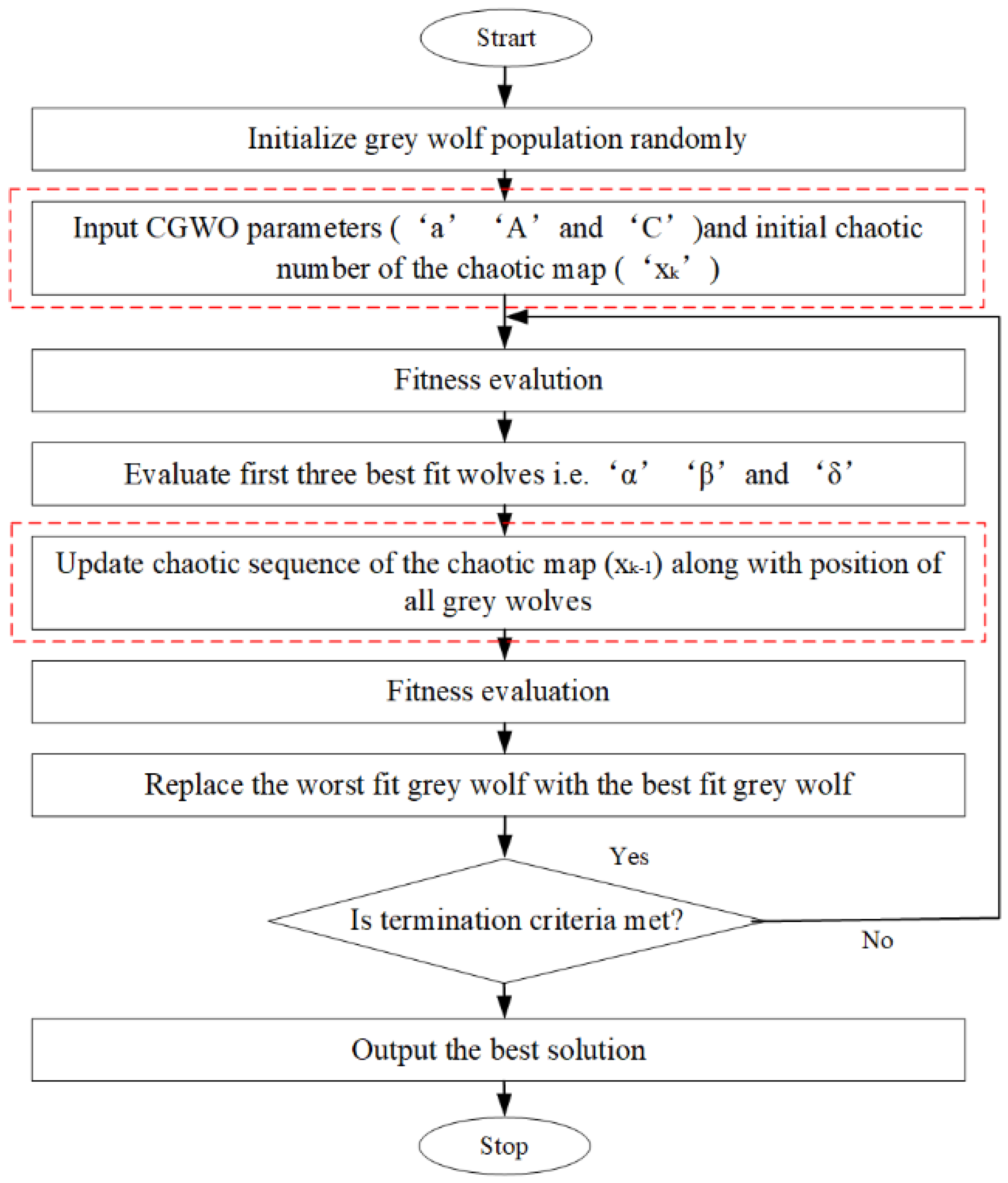

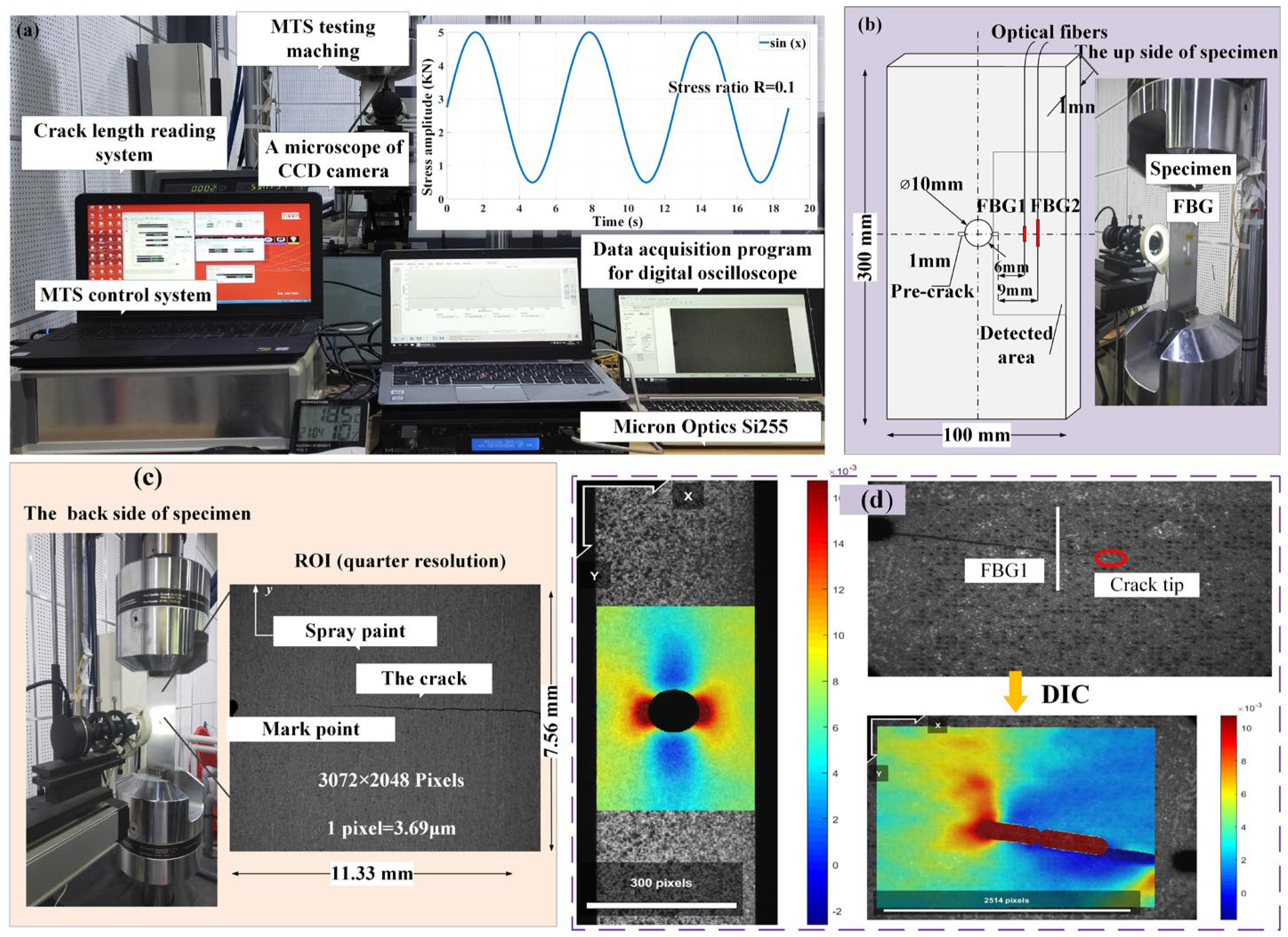
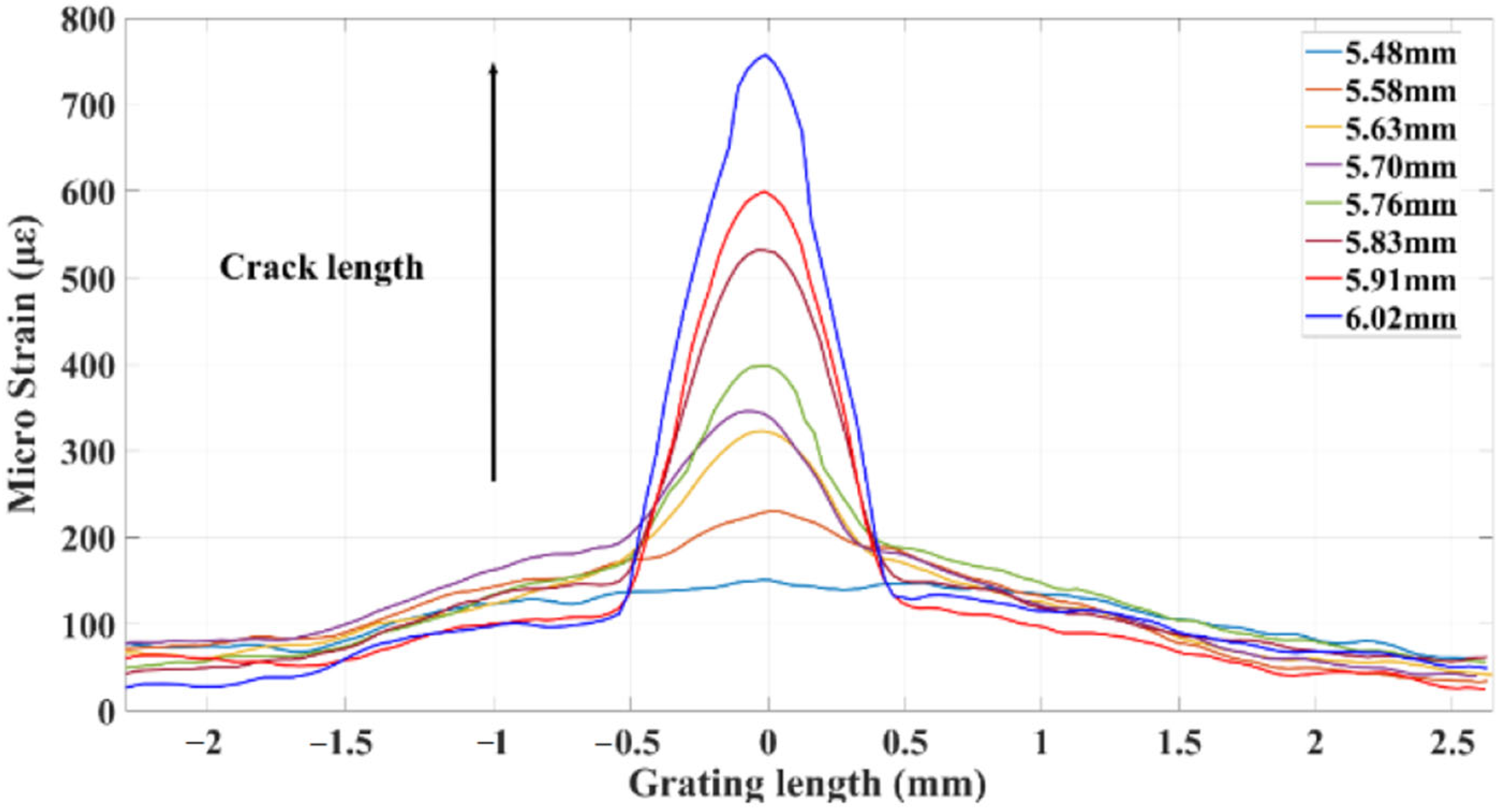

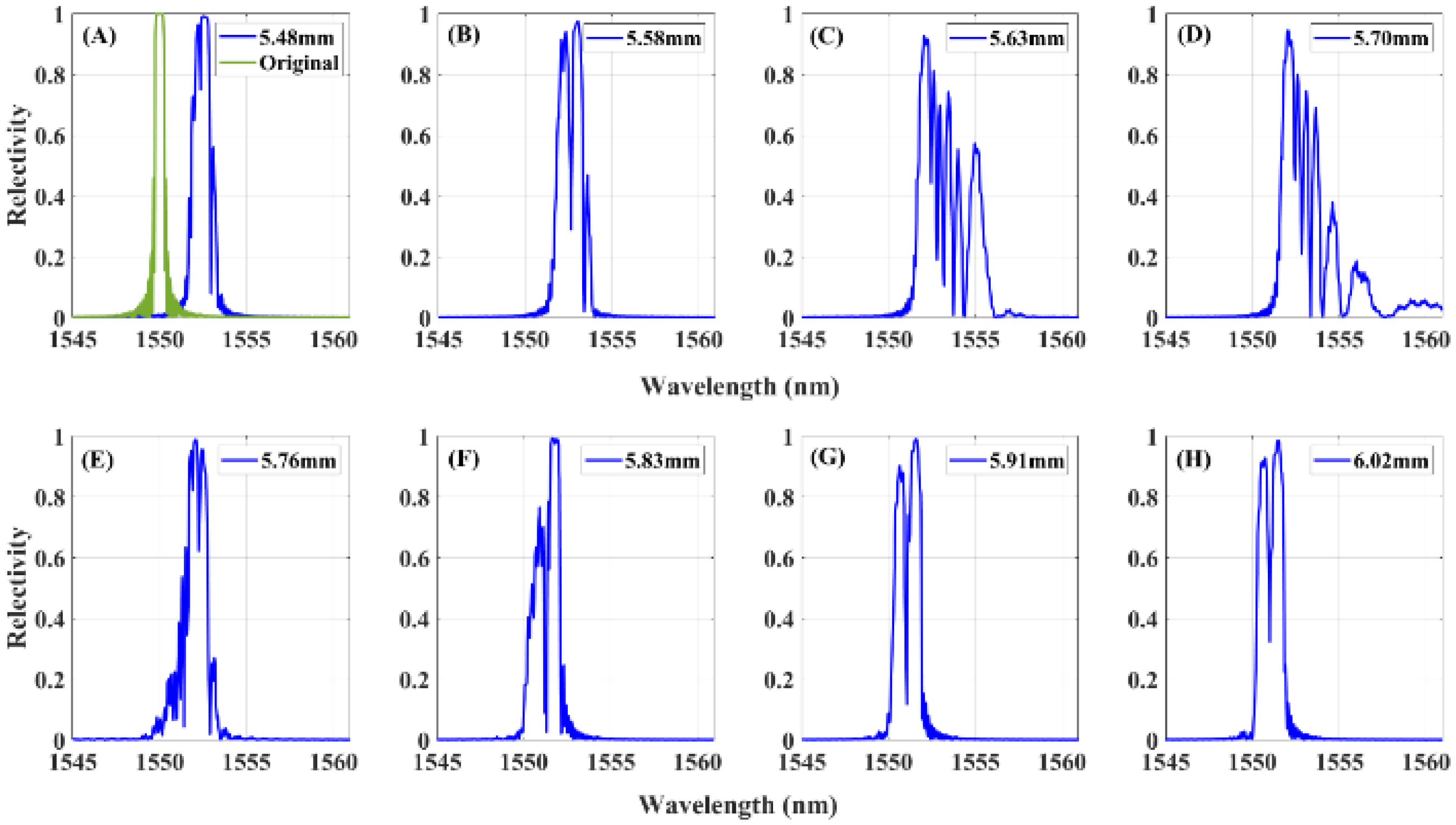
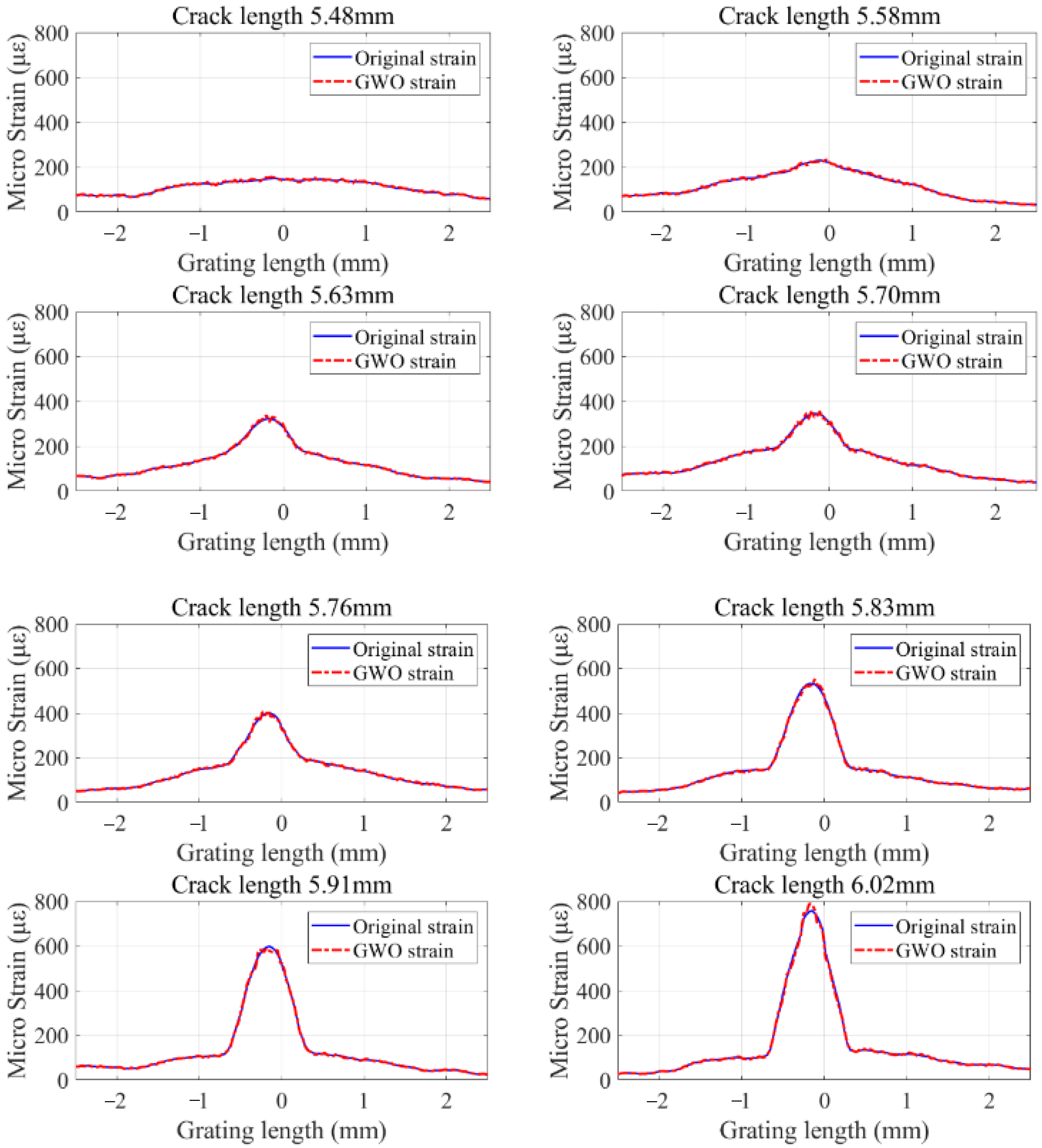
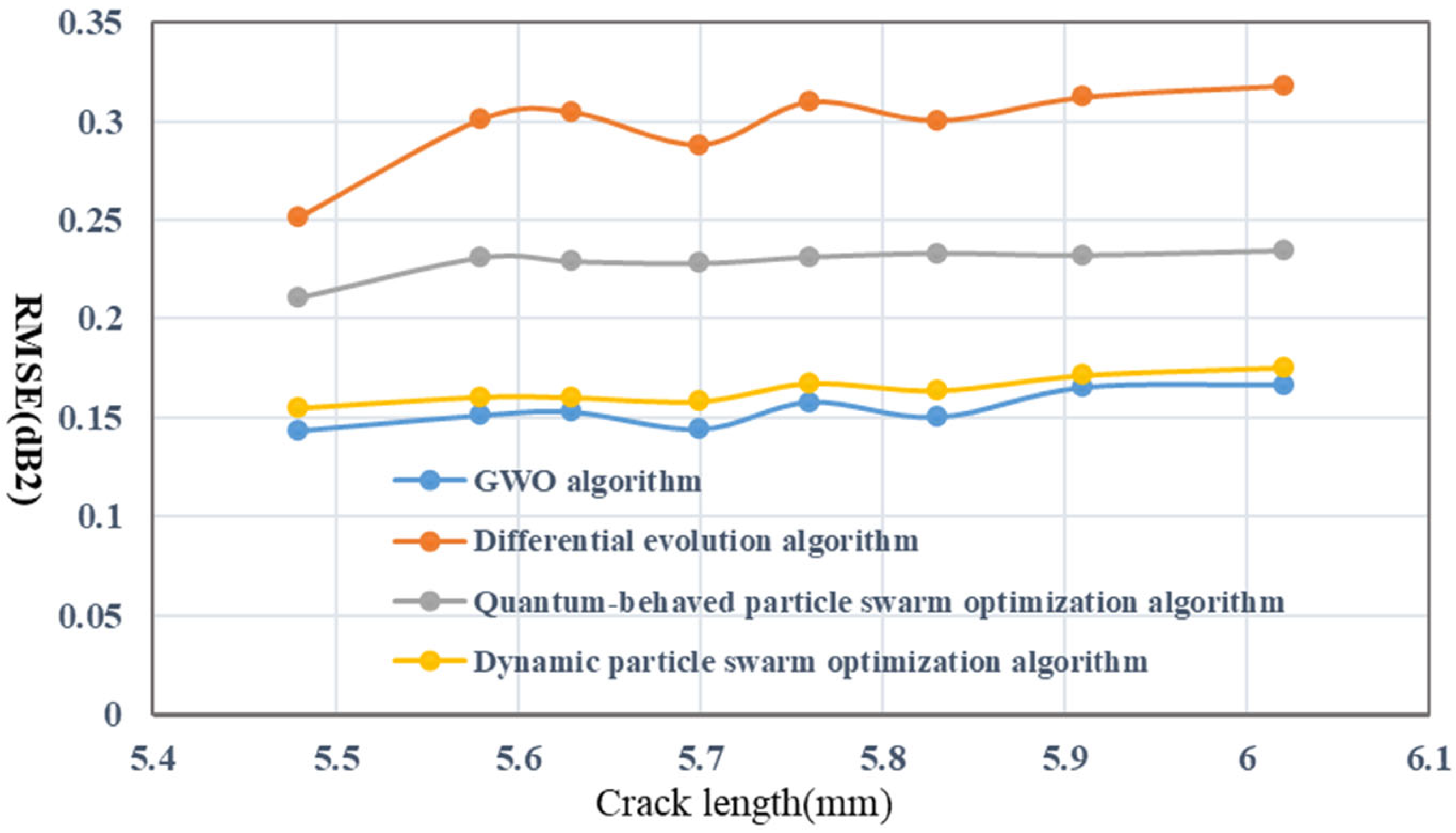
| Number of Sensors | FBG1 | FBG2 | FBG3 |
|---|---|---|---|
| Grating length (m) | 0.0051 | 0.0100 | 0.0051 |
| Effective refractive index | 1.450 | 1.458 | 1.450 |
| Bragg wavelength (nm) | 1550 | 1550 | 1550 |
| Poisson's ratio | 0.17 | 0.17 | 0.17 |
| Average index change | 2.0 × 10−4 | 2.6 × 10−4 | 2.0 × 10−4 |
| Distance between FBG and original crack tip (mm) | 6 | 9 | 9 |
| Sensor side position | up | up | back |
| Crack length (mm) | 5.48 | 5.58 | 5.63 | 5.70 |
| RMSE (dB2) | 0.1434 | 0.1511 | 0.1528 | 0.1441 |
| Crack length (mm) | 5.76 | 5.83 | 5.91 | 6.02 |
| RMSE (dB2) | 0.1578 | 0.1502 | 0.1653 | 0.1666 |
Disclaimer/Publisher’s Note: The statements, opinions and data contained in all publications are solely those of the individual author(s) and contributor(s) and not of MDPI and/or the editor(s). MDPI and/or the editor(s) disclaim responsibility for any injury to people or property resulting from any ideas, methods, instructions or products referred to in the content. |
© 2023 by the authors. Licensee MDPI, Basel, Switzerland. This article is an open access article distributed under the terms and conditions of the Creative Commons Attribution (CC BY) license (https://creativecommons.org/licenses/by/4.0/).
Share and Cite
Zhang, M.; Wang, J.; Xiong, X.; Chen, Z.; Gong, Y.; Gao, S.; Zhang, W. The Strain Distribution Reconstructions Using GWO Algorithm and Verification by FBG Experimental Data. Appl. Sci. 2023, 13, 1259. https://doi.org/10.3390/app13031259
Zhang M, Wang J, Xiong X, Chen Z, Gong Y, Gao S, Zhang W. The Strain Distribution Reconstructions Using GWO Algorithm and Verification by FBG Experimental Data. Applied Sciences. 2023; 13(3):1259. https://doi.org/10.3390/app13031259
Chicago/Turabian StyleZhang, Meng, Jingyan Wang, Xiao Xiong, Zihan Chen, Ying Gong, Sisi Gao, and Weifang Zhang. 2023. "The Strain Distribution Reconstructions Using GWO Algorithm and Verification by FBG Experimental Data" Applied Sciences 13, no. 3: 1259. https://doi.org/10.3390/app13031259
APA StyleZhang, M., Wang, J., Xiong, X., Chen, Z., Gong, Y., Gao, S., & Zhang, W. (2023). The Strain Distribution Reconstructions Using GWO Algorithm and Verification by FBG Experimental Data. Applied Sciences, 13(3), 1259. https://doi.org/10.3390/app13031259






